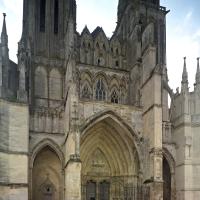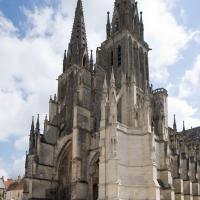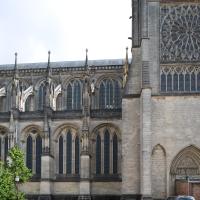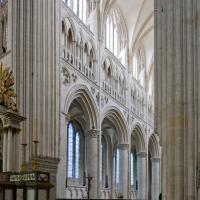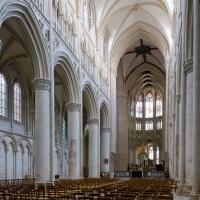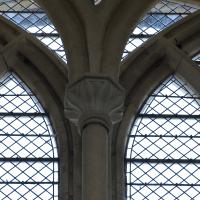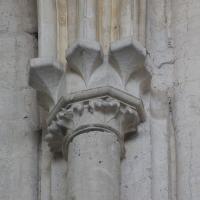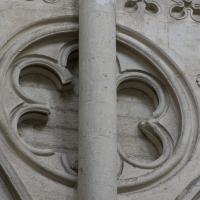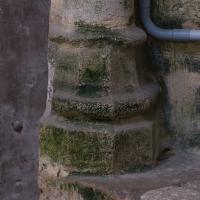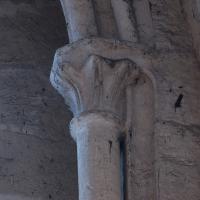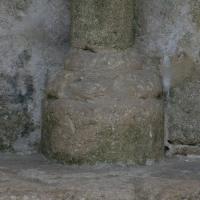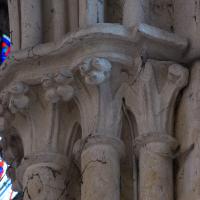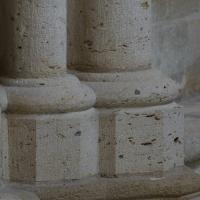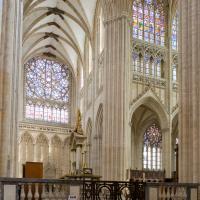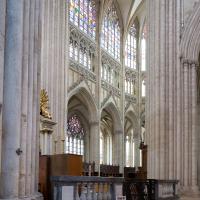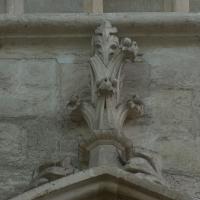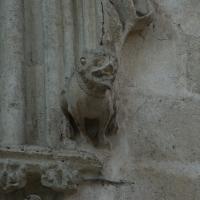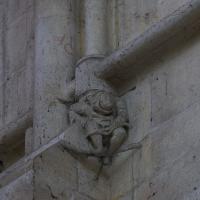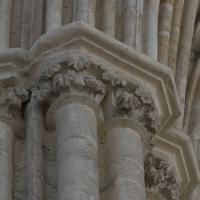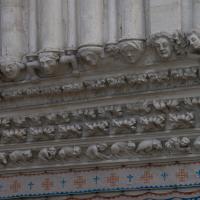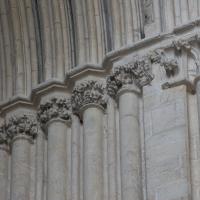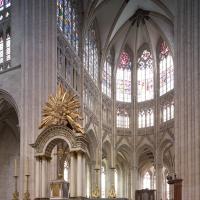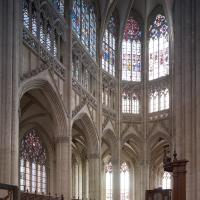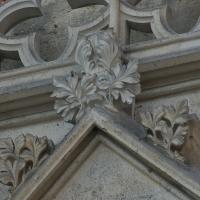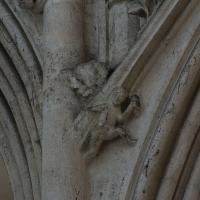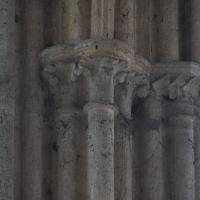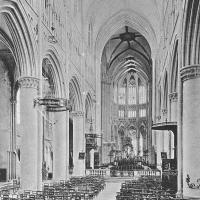Images
VR Tour
Notes
History
There had been a Romanesque cathedral on the site, begun in 1060 and consecrated in 1126. It may have been burnt during the hostilities with the French in 1150 or 1174. In 1131 the chapter had adopted Victorine rule. The 12th-century canons' cloister lay to the north of the church, affecting the design of the north nave aisle
Date
Begun ca. 1240
Plan
A seven-bay aisled basilical nave is terminated to the west with a twin-towered western frontipiece. The towers are supported upon substantially-thickened outer walls and tower-supporting arcade piers. From the crossing is generated a deeply-projecting assymmetrical transept without aisles. The stubby two-bay aisled chevet terminatees in a five-segment hemicycle ringed by an ambulatory and five deep radiating chapels (the axial chapel was extended in length in the nineteenth century.
Elevation
The nave has a three-story elevation with a dark triforium in the middle. The outer walls of the aisles have a remois passage. The supports are cylindrical with a little colonnette on the front (like Soissons Cathedral); the arcade wall is thickish with three principal orders of deeply-undercut mouldings. Cusped oculi, deeply carved, enliven the spandrels of the arcade. The glorious feature of the nave elevation is the middle level, the triforium, where a narrow central double unit is flanked by two wider double units, all in "Y" tracery. The supporting colonnettes are woven into a lower balustrade. The clerestory, set back and only partially linked with the triforium, is double-skinned. Substantial buttresses has been inserted in the main supports blocking what was originally presumably a clerestory passage. Quadripartite rib vaults with skinny ribs and transverse arches. The choir also has a three-story elevation, but with a glazed triforium. The piers have additional colonnettes and each arch of the arcade is capped with a gable. The arcade spandrels are articulated with vertical panels which are lined with the triforium where the sycopated rhythm of the nave has been abandoned in favor of tripartite regularity. Highly developed, Parisian-looking tracery motifs in the tall clerestory.
Chronology
The western frontispiece and nave were begun c1240 under Bishop Geoffroy de Maiet, previously a canon at Rouen Cathedral. The choir is firmly dated. The tomb of Bishop Jean de Bernières (1278-93) describes him as the builder of the cathedral. The high altar was consecrated in 1310, and the choir clerestory contains images of donors who may be fixed in time to the 1270s. Work on the transept and nave may have begun as early as 1260. The work is remarkably unfied and must have been completed rapidly.
Sculptural Program
The north portal was completely redone in the nineteenth century, and shows St. Dionysius' martyrdom. The voussoirs show Old Testament figures; Moses and Aaron in particular can be discerned on the outer band. The signs of the zodiac are carved on the doorposts. We know from Suger's writings, however, that this portal would originally have been a mosaic, an unusual addition to a French church at the time, and one of which Suger was quite proud. It was most likely a scene showing the Coronation of the Virgin, perhaps after the Italian example in Montecassino that he had seen on his travels.
Significance
The nave makes multiple references to the upper parts of the nave and the choir of Bayeux Cathedral and to the choir of Le Mans Cathedral: Grant suggests that the Sées nave master had worked at Bayeux. Links may also be established between Sées and Rouen. Art historians have generally hailed the Sées nave as a masterpiece. The choir, with its delicate, mannered forms, is also a remarkable tour de force. It refers to Parisian rayonnant prototypes and to the church of S-Urbain in Troyes. The contemporary choir of Evreux Cathedral provides a parallel. Restorations The western frontispiece was consolidated in the fifteenth century with the construction of a flying buttress between the central and north portals -- work consolidated under Bishop Jaques de Silly with an enormous buttress, supplemented with another one against the south side in 1560. The culées of the choir flying buttresses were also thickened and the north transept rose redone. In the 18th century architect Joseph Brousseau consolidated the north flank of the nave and replaced the stone gables over the transept roses. In the 19th century Alavoine clad the north side of the western frontispiece using iron for colonnettes and pinnacles. His successor Delarue rebuilt SW tower to match the north one creating symmetry that had not existed. Architect Dedraux reworked S flank of the nave but was dismissed in 1850. Major restoration work was done by Victor Ruprich-Robert who was convinced that the foundations were inadequate and proceeded to rework en sous-oeuvre. 1856 south transept finished; 1869 north side. The choir was entirely demolished and rebuilt and axial chapel was extended by one bay.
Location
Bibliography
Grant, Lindy, Architecture and Society in Normandy, New Haven, 2005, 193-5; 213-215
Lafond, Jean, Les vitraux de la cathédrale de Sées, Paris, Soc. Franç d'arch., 1955,
Olde-Choukair, Christiane, "Les travaux de restauration de la cathédrale de Sées du XV au XIX siècles," Bulletin de la Société Historique et Archéologique de l?Orme, 118, 3-4 1998, 69-98
Sandron, Dany, "Les restaurations de la cathédrale de Sées du XV au XIX siècle," Bull mon, 158, no 3, 2000, 264-5





